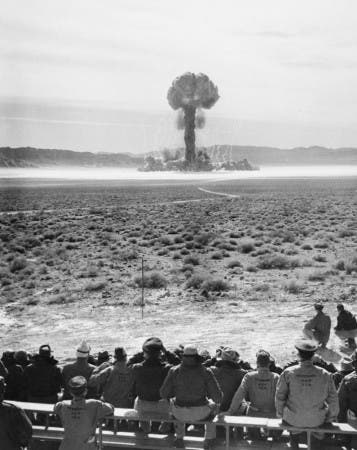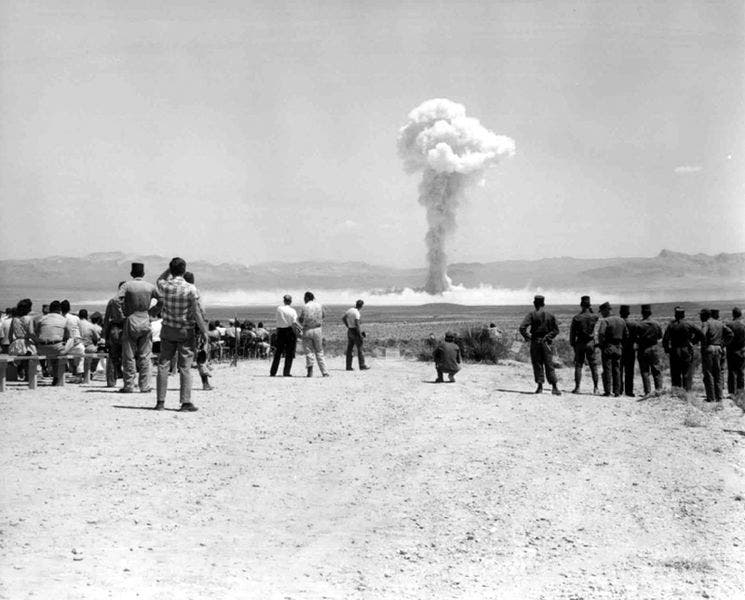
Let’s play a game of trivia. I’ll go first: what’s the fastest man-made object that humans have ever launched?
A hypersonic jet? Wrong. Maybe a super powerful Apollo-era spacecraft or a fancy SpaceX rocket? Nope.
The correct answer is a manhole cover that was shot into freaking space by a nuclear bomb detonated in a shaft that it was covering. Here’s the story behind this ridiculous, but nevertheless true historical event.
Blast off
The top-secret Manhattan Project that saw the development of the first nuclear bomb at the end of WWII was just the beginning of a long era of nuclear weapons research and development. Between 1945 and 1992, the United States alone detonated more than 1,000 nuclear warheads during tests, some more powerful than others.
For obvious reasons, these weapons of mass destruction were detonated in highly secluded areas of the country, like in the New Mexico and Nevada deserts, or in the Marshall Islands located in the middle of the Pacific Ocean. Even so, scientists were rightfully worried about the nuclear fallout from these tests that could travel through the atmosphere and affect civilians.
So in the late 1950s, the Pentagon decided that the vast majority of its tests should be performed underground. These weren’t the first nuclear tests underground, but these would be the first that would be designed with absolute nuclear containment in mind.

This brings us to Pascal A, the first such test, which was conducted on the night of July 26, 1957. The bomb was placed at the bottom of a hollow column approximately 150 meters (485 feet) deep. A 900-kilogram, 10-cm (4-inch) iron cap was welded on top. Within just a couple of milliseconds of the bomb’s detonation, the cap was jettisoned as the explosion climbed up the column, forming a Roman candle-like plume in the atmosphere above the shaft.
For Pascal B, the second underground planned test, scientist Robert Brownlee was ordered to calculate the bomb’s shockwave inside the underground shaft, including the time and specifics of the shockwave as it reached the metal cap. In a 2002 essay, Brownlee recounts an exchange with Bill Ogle, the deputy division leader, which would go on to become the stuff of legend.
Ogle: “What time does the shock arrive at the top of the pipe?”
RRB: “Thirty one milliseconds.”
Ogle: “And what happens?”
RRB: “The shock reflects back down the hole, but the pressures and temperatures are such that the welded cap is bound to come off the hole.”
Ogle: “How fast does it go?”
RRB: “My calculations are irrelevant on this point. They are only valid in speaking of the shock reflection.”
Ogle: “How fast did it go?”
RRB: “Those numbers are meaningless. I have only a vacuum above the cap. No air, no gravity, no real material strengths in the iron cap. Effectively the cap is just loose, traveling through meaningless space.”
Ogle: And how fast is it going?”This last question was more of a shout. Bill liked to have a direct answer to each one of his questions.
RRB: “Six times the escape velocity from the earth.”
“Bill was quite delighted with the answer, for he had never before heard a velocity given in terms of the escape velocity from the earth! There was much laughter, and the legend was now born, for Bill loved to report to anybody who cared to listen about Brownlee’s units of velocity. He says the cap would escape the earth. (But of course we did not believe that would ever happen.),” Brownlee wrote.
Except that’s exactly what seemed to have happened. In order to measure the velocity of the metal cap, Brownlee’s team decided to mount a high-speed camera that would record the event. But once the bomb was detonated on August 27, 1957, the cap appeared above the hole for just one frame, so there could be no direct velocity measurement. Instead, Brownlee estimated it was “going like a bat!!” which doesn’t sound very scientific but makes for a very visual description.
Brownlee later calculated that the cap must have been traveling at about 125,000 miles per hour or five times the escape velocity of Earth.
Everyone expected to find the manhole cover somewhere, but they never did. In fact, it might have very well ended up in space — months before the Soviet Union’s Sputnik 1 launched from Earth becoming the first artificial satellite in history. In fact, the nuclear blast must have sent manhole cover well beyond Earth’s orbit and gravitational grasp, likely shooting off into outer space.
So not only was this daring manhole cover the fastest man-made object in history, but it may have also been one of the first objects that reached outer space.
Later tests were designed better such that total containment of the nuclear blast was eventually reached.
“I’ll add that we learned a lot with our series of low-yield tests. Plugs helped, but the closer to the nuclear device, the better. “Tamping” the device is better yet, and there are some ways to do that which are more clever than others. Mostly we learned that even an empty hole could cause a reduction to the atmosphere of as much as 90 percent, depending on specific design parameters. Later we were to see that if the hole is deep enough and the yield is high enough, an empty hole will close completely, allowing nothing whatsoever out except the initial light, which is not radioactive of course. In time, the tests became very sophisticated-and expensive, but we were able to achieve complete containment for almost every test, and for all but a handful of those that had containment “failures”, nothing was detected off-site. So I would judge our containment efforts to be quite successful,” Brownlee said.
This article was originally published in January 2021.


